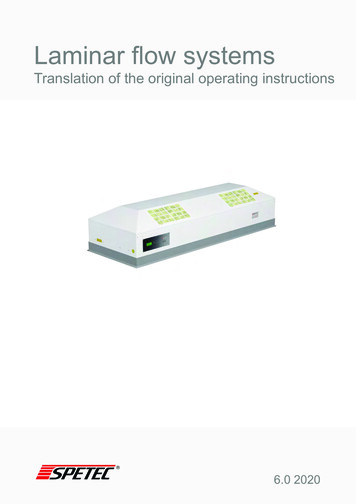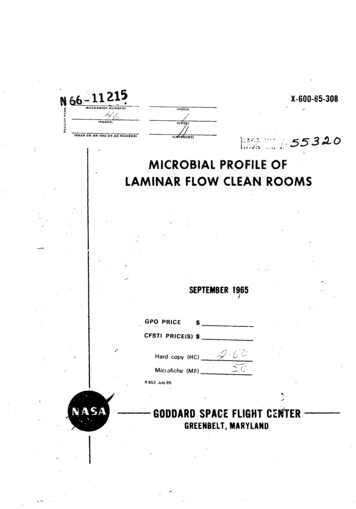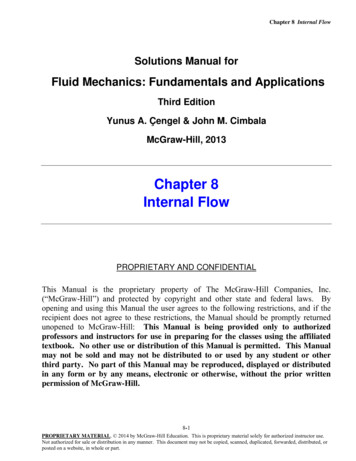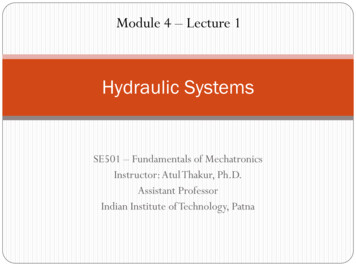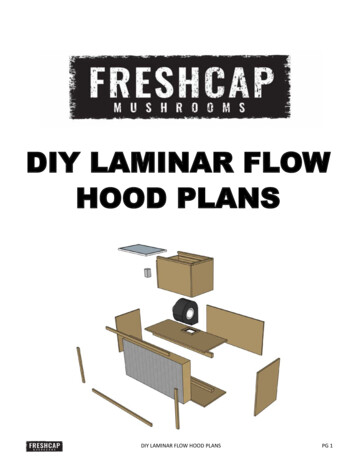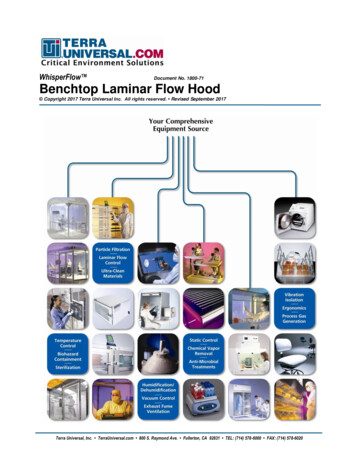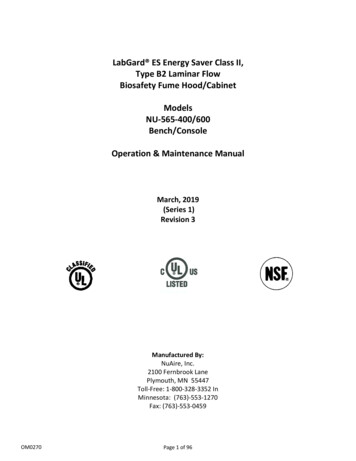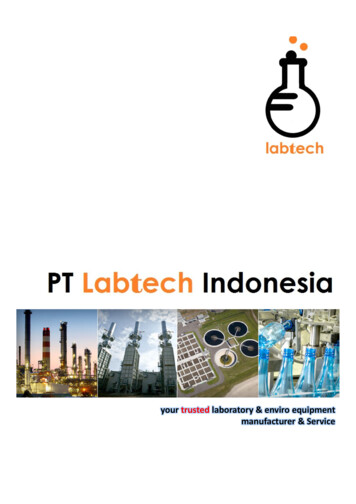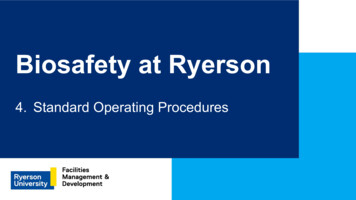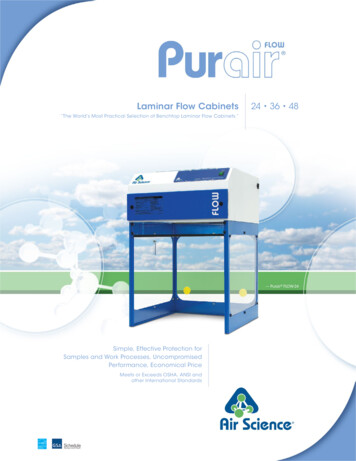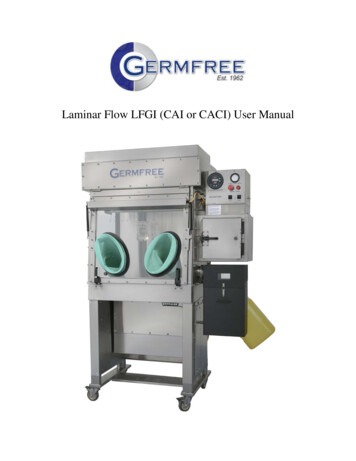
Transcription
Laminar Flow LFGI (CAI or CACI) User Manual
GERMFREE4 Sunshine Blvd.Ormond Beach, FL 32174800-888-5357 Phone386-677-1114 FaxInfo@Germfree.comwww.Germfree.com2
Table of ContentsPREFACE6SAFETY, OPERATION AND ADDITIONAL PROFESSIONAL TRAININGGERMFREE, THE LFGI AND USP 797 67INTRODUCTION8PRODUCT PROTECTIONPERSONNEL PROTECTIONPARTICULATES AND GASES/ VAPORS8910THEORY11HEPA FILTRATIONUNIDIRECTIONAL (LAMINAR) AIR FLOWPRESSURIZATIONCONTAINMENT11121213UNPACKING INSTRUCTIONS14INSTALLATION15ELECTRICAL REQUIREMENTS17CERTIFICATION17PARTS IDENTIFIER18FRONT OF LFGIINSIDE THE WORK AREAINSIDE THE WORK AREA #2SHARPS AND WASTEBACK OF THE CONTROL PANELCONTROL PANEL181819192020CLEANING21OUTSIDE THE LFGIINSIDE THE LFGI21213
OPERATION21SAFETY AND ADDITIONAL TRAININGSTART-UPOPERATION212223AIRLOCK OPERATION24USAGE25DO NOTDOPRACTICE PROPER ASEPTIC TECHNIQUESHARPSWASTE REMOVAL2526262828APPENDICES29WARRANTY INFORMATION (2 YEAR STANDARD)MAINTENANCELIGHT BULB REPLACEMENTDUCTINGELECTRONIC ADJUSTING STANDAUTOMATED COMPOUNDERSALARMPROCEDURE FOR CHANGING GLOVES DURING MAINTENANCESLEEVE CHANGESGLOVE AND SLEEVE INSPECTIONSCLEANING THE LFGI- HEAVY DUTY (RIGOROUS)OUTSIDE THE LFGIINSIDE THE AIRLOCKINSIDE THE LFGICLEANING THE LFGI BETWEEN PREPARATIONS- LIGHTCLEANING AGENTSCLEANING TERMS2930323333343637414243434345464849LFGI- USP SPECIFICATION SHEETS51CERTIFICATION OF GERMFREE LAMINAR FLOW GLOVEBOX /ISOLATOR63PRODUCT OVERVIEWBASIC OPERATIONAIRFLOW SET UPSUPPLY VELOCITY636464644
ISOLATOR PRESSUREPARTICLE COUNTSFILTER INTEGRITYBACK OF THE CONTROL PANELREPLACEMENT FILTER SIZES & PART NUMBERSSENSOCON CONTROLLER USER MANUAL6465656767575
PrefaceSafety, Operation and Additional Professional TrainingThe Stainless Steel Laminar Flow Glovebox /Isolator (LFGI) provides a containedenvironment that allows for greater protection for both personnel and product thantraditional open front laminar flow equipment. However, this protection can only beachieved through proper technique. The following is a list of topics that may apply to youroperation. Many of these items may require additional professional study and practicebeyond the information found in this manual.1.2.3.4.5.6.7.8.9.10.Operation of the Laminar Flow Glovebox /IsolatorUnderstanding HEPA particulate filtrationProper operator techniqueUnderstanding chemical compatibilities for proper glove selectionUnderstanding chemical compatibilities for proper “cleaning” and “sterilization”Understanding chemical compatibilities for proper “decontamination”Understanding sterile product preparation and aseptic techniqueUnderstanding hazards associated with the products handled in the Laminar FlowGlovebox /IsolatorUnderstanding proper maintenance and initial and periodic certificationUnderstanding Federal, State and Local applicable professional regulations.The Laminar Flow Glovebox /Isolator does not automatically provide a clean, sterile andsafe working environment. In order for the LFGI to provide the required work environmenta professional understanding of the above 10 items along with a complete understanding ofthe tasks to be performed is essential.To obtain this information and understanding may require additional professionaltraining. If you need assistance in finding Professional Pharmacy Organizationsoffering additional training for any of the above items please call PharmacyEquipment Sales at GERMFREE, 800.888.53576
GERMFREE, the LFGI and USP 797 GERMFREE has strived to produce a primary engineering control that maintains a cleanand microbe free environment through a combination of design elements andrecommendations for good practice and technique.USP 797 does not offer a great deal of guidance on the use of barrier isolators for thecompounding of sterile products and has left much to the manufacturer’s recommendation.In light of this, GERMFREE will always err on the side of caution when makingrecommendations on the proper use of the LFGI.GERMFREE recommends the following regarding the general use of the LFGI in thepharmacy environment:1. The LFGI should be placed in a controlled environment. A room with a window thatopens to the out of doors or with high foot traffic is not appropriate for the compoundingof sterile products. This is recommended to reduce the overall bioburden in the surroundingarea. A classified environment or a room that conforms to a particular particle count is notnecessary. The LFGI is designed with a sealed airlock that maintains completeenvironmental separation between the work area and the ambient room air. This sealedairlock is then purged with HEPA filtered air to equalize or better the cleanliness level ofthat contained air to the ISO Class 5 condition of the work area.2. (For CACI Model- Handling Hazardous Drugs) Operators should wear a gown or coatto protect themselves from accidental dermal contact with elements being compounded.3. Operators should always wear gloves when handling compounding elements before andafter they are compounded in the work area. Studies show drug contamination on theoutside of vials.4. Operators should minimize fingernail length and jewelry since they increase the chancesfor glove puncture / tear.5. All compounding elements should be wiped down before placement in the airlock toreduce any surface contamination that may be present.7. Operators should wipe down the exterior of waste or sharps containers that are usedinside of the work area prior to removal from the LFGI with alcohol.8. Current standards of practice should prevail. For example, if you do not compoundantibiotics and TPNs concurrently in your Laminar Flow Workstation, do not compoundthem at the same time in the LFGI.9. Operators should be made aware that “first air” for the purposes of proper aseptictechnique is now located above the work area. This will change how they utilize the workdeck space.7
IntroductionThe Stainless Steel Laminar Flow Glovebox /Isolator is a complete barrier system. Itprovides sterile laminar flow air for aseptic pharmacy preparations while protectingpharmacy personnel from hazardous materials.The Laminar Flow Glovebox /Isolator uses an amalgamation of cleanroom andcontainment technologies designed specifically for critical pharmacy applications. This unitprovides laminar flow air for product protection and complete containment for operatorprotection.Product ProtectionThe Laminar Flow Glovebox /Isolator offers the highest level of product protection byproviding vertical unidirectional (laminar) flow HEPA filtered air to the complete workenvironment. The unit utilizes a full width and depth supply HEPA filter above the worksurface. The entire work area is bathed in HEPA filtered unidirectional mass displaced air.This provides a better than ISO Class 5 particulate-free environment. Particulates generatedby manipulations are continuously removed, maintaining ISO Class 5 or better conditionswhen operational. All air entering the LFGI is twice filtered, once by the pre-filter then bythe supply HEPA filter.8
Personnel ProtectionThe Laminar Flow Glovebox /Isolator provides personnel protection by maintaining acomplete barrier from hazardous material in the work area. All air exiting the Glovebox/Isolator passes through the exhaust HEPA filter, which remove hazardous dust, powders,aerosols and other particulates. All air entering the Laminar Flow Glovebox /Isolator passesthrough the inlet HEPA filter which maintains the barrier. Personnel operate in the workarea through gloves in a sealed view panel. Glove changes can be made while maintainingcontainment, furthering personnel protection.9
Particulates and Gases/ VaporsThe Laminar Flow Glovebox /Isolator provides personnel and product protection fromparticulates, dust, powders and aerosols. Microbiological particulates and aerosols, with thepossible exception of Prions, are also removed. Personnel and product protection from gasand fumes is not provided by HEPA filtration, but limited protection from gas and fumescan be provided by venting or ducting. The LFGI can be configured to meet therecommendation for no recirculation and total exhaust of all air exiting the work area madeby the NIOSH alert on the handling of hazardous drugs.10
TheoryHEPA FiltrationThe Laminar Flow Glovebox /Isolator uses HEPA (High Efficiency Particulate Air) filtersto provide the highest level of personnel and product protection. These filters are thelaminar flow supply HEPA filter, which filters all air passing over the entire work area, andthe exhaust HEPA filter that filters all air exiting the Laminar Flow Glovebox /Isolator.Additionally, there are two HEPA filters located inside the HEPA Purge airlock that filterthe purged air. All filters are rated to remove particulates and aerosols 0.3 micron in sizewith a minimum efficiency of 99.99%. These filters are even more effective at removingparticulates both larger and smaller than 0.3 microns as the graph below depicts.11
HEPA filters are recognized as one of the finest forms of mechanical air filtration availablefor this application. HEPA filters improve or become more efficient as they load under use.There are a number of mechanisms involved in HEPA filtration which are briefly presentedbelow:1.Impingement - Large particulates, e.g. dust, are captured by the filter fibersair stream flows around the fibers.2.as theInterception - Particulates follow air stream around filter fibers and becomecaptured (physical interference between particles and fibers).3.Diffusion - Very small “particles” are bombarded by gas molecules causingto move erratically (Brownian motion) and contact the filter fibers.them4.Straining - Occurs when the smallest dimension of the particulate is greater than thedistance between adjoining filter media fibers.5.Electrostatic attraction - Enhances mechanical capture through attraction ofoppositely charged particles.Unidirectional (Laminar) Air FlowThe Laminar Flow Glovebox /Isolator offers the highest level of product protection byproviding vertical laminar flow HEPA filtered air to the complete work environment. Thisis the same technology used in the Laminar Flow Workstations and Biological SafetyCabinets that “barrier isolators” are intended to replace. The Laminar Flow Glovebox/Isolator utilizes a full width and depth supply HEPA filter above the work surface. Anyparticle-laden air is swept from the work area with a wash of HEPA filtered air. Filtered airwashes over the work area into the front and rear grilles. Particles that are generated by thework are immediately washed into the returns and out of the work zone. Internal crosscontamination from compounding different products in the same work area is drasticallyreduced.PressurizationThe Laminar Flow Glovebox /Isolator can be configured for either positive or negativepressure operation. When the system is operating under positive pressure it is referred to asan Isolator and when operating under negative pressure it is referred to as a Glovebox. Negative pressure Glovebox operation should be used when personnel protectionhas been determined to be of greater concern.12
Positive Pressure Isolator operation should be used when product protection hasbeen determined to be of greater concern.In either positive or negative pressure configurations the airflow in the LFGI is always in thesame direction. To achieve positive pressure the supply blower pushes air into the chamberfaster than it is exhausted. This causes the gloves to push out of the work area. To achievenegative pressure the exhaust blower pulls air out of the chamber faster than it is taken in.This causes the gloves to pull into the work area.The decision to operate the Laminar Flow Glovebox /Isolator under negative or positivepressure must be determined based on your intended product application, risk assessmentand current regulations. The design of the LFGI series allows a certifier to change theoverall pressure of the unit while in-place. This requires in-depth knowledge of the LaminarFlow Glovebox /Isolator and its components and should not be attempted by a user.ContainmentThe Laminar Flow Glovebox /Isolator maintains containment of the work area through aseries of filters and its stainless steel construction. Joints are welded and polished for easycleaning and all modular components are fully gasketed to ensure a gas tight seal. Adjustablecompression hinges and positive-lock latches deliver consistent pressure at door openings.The two door airlock functions to maintain complete environmental separation between theroom and work area air.All air entering and exiting the LFGI is HEPA filtered to ensure ambient particulates stayout of the work area and materials being compounded stay in.13
Unpacking InstructionsThe Laminar Flow Glovebox is shipped fully assembled in a single crate. All equipmentmust be inspected immediately upon receipt. If there is visible damage to the container orunit it must be noted on the receiving documents by the driver. The carrier must then benotified to arrange for an immediate inspection to verify the damage to the equipment. Ifdamage to the unit is found after it is uncrated (concealed damage), the receiver shouldnotify the delivering carrier at once. Do not move the equipment or discard any of theshipping materials until a concealed damage inspection is performed. If the carrier will notperform this service, please contact the factory immediately at 800- 888-5357. Without thisinspection of the equipment and packing materials, the freight company may not accept aclaim for damage or loss and take the position that the damage occurred after delivery.Packaged LFGI1. Packing List2. Pallet with donut lifts forpallet jack3. Casters are locked forshipping and are touchingthe mounting rack.LFGI is on a rack toprevent movement duringshipping.DO NOT USE A FORKLIFT TO REMOVE LFGIFROM THE PALLET14
Packed Airlock1. Sleeves with gloves and O-rings2. Cleaning kit with stainless steel cleaner,abrasive pad, hanging hooks and scratchremover3. Complimentary box of glovesAdditionally- 1-Yellow Electrical OutletCord (can not be seen in this picture).InstallationThe Laminar Flow Glovebox /Isolator was designed to fit through standard size doorsallowing for easy installation (32” Deep and 80” High).The Laminar Flow Glovebox /Isolator is a complete and self-contained unit and is shippedfully assembled. After unpacking, the unit can be moved into the desired location. Unlike anopen front hood room air currents do not disrupt the LFGI; however, proper roomplacement and room access may be defined by professional and/or State regulations.The external clean air plenum may be removed if it is discovered that the unit is too wide tofit through a door. The Prefilter housing at the top of the LFGI can be removed if the unitis too tall. Please call GERMFREE (800) 888-5357 for instruction if either of these isnecessary.15
The sleeves and gloves will need to be installed before turning the unit on. See section onSleeve and Glove Changes.16
Electrical RequirementsElectrical Requirements are as follows:LFGI-3USPLFGI-4USPLFGI-6USP115V, 15 amp plug for one 10 ft. Power cord115V, 15 amp plug for one 10 ft. Power cord115V, 15 amp plug for one 10 ft. Power cordIt is essential that the equipment be properly grounded, it is a violation of your warranty tooperate without.For service to the unit it is essential that the cord cap be easily accessible.Optional Equipment affects Electrical Requirements in the following wayElectrical Height Adjustment requires its own power receptacle and a 15 amp circuit on allsized units.Additional electrical components may be required based upon equipment used inside theLFGI.CertificationThe Laminar Flow Glovebox /Isolator is a complete and self-contained unit whoseperformance was tested and documented before shipping. It requires certification after theunit has been installed and prior to operation. This is especially important aftertransportation of the LFGI from our factory to your facility. The purpose of this retesting isto verify that the HEPA filters, airflows and pressures are within limits and the unit isperforming properly.It is always a good idea to review basic operation of your new LFGI with the certificationcompany personnel due to their knowledge of this type of equipment.Certification may also be a Governmental and /or Professional requirement.LFGI certification needs to be performed by a company that has the proper equipment andtraining needed to test and measure HEPA filter performance. Certification of the LFGIshould be continued at least annually or as regulations dictate.Please contact GERMFREE at 800-888-5357 for a list of Certification Companies in yourarea if you do not already have this service.17
Parts IdentifierFront of LFGI1. Airlock2. Control Panel3. Prefilter Housing4. Supply HEPA Filter AccessPanel5. Light Housing6. Work Area7. Gloveport8. Viewing Panel Lift9. Locking View Panel Latch10. Sharps and Waste RemovalTubes11. Exhaust HEPA Filter AccessPanel12. Foot Rest13. Hydraulic HeightAdjustment Handle14. Locking CastersInside the Work Area1. Exhaust HEPA Filter2. Sliding Work Tray3. Return Air Grilles4. Electrical Outlet5. Inner Airlock Door6. Sharps Tube7. Waste Tube18
Inside the Work Area #21. Electrical Outlet Connector2. Airlock Inlet HEPA FilterDiffuser/Protector3. Sliding Airlock Tray4. Work Area HEPA FilterDiffuser/ProtectorSharps and Waste1. Outside of the Airlock2. Sharps Tube3. Waste Tube (will come with a coverand a clamp that can be removed if thisfeature is to be used. Clamp can beused to secure waste bags.)4. Adjustable Sharps Collector Shelf5. OPTIONAL Stainless Garbage Can19
Back of the Control Panel1. Supply Blower Control *CertifiersOnly2. Exhaust Blower Control *CertifiersOnly3. Unit Power Cord4. Supply Blower Power Cord5. Light Housing Power Cord6. Exhaust Blower Power Cord7. Work Area Outlet Power Cord8. Airlock Supply HEPA Filter CoverControl Panel1. Minihelic Gauge forSupply HEPA filter2. Digital Work AreaPressure Gauge3. Light Switch4. Circuit Breaker5. Main LFGI BlowerPower6. Purge Start Button7. Purge OperationLight20
CleaningOutside the LFGIThe outside of the LFGI can be cleaned at any time while the unit is closed and theprocedure does not require Personal Protective Equipment (PPE) additional to thatnormally used when operating the LFGI. The stainless steel should be cleaned using a 70%alcohol solution or a solution specifically designated for the cleaning of stainless steel. Theacrylic front and side panels should be cleaned with a soft cloth and a mild detergent, or asolution specifically designated for the cleaning of acrylic surfaces.It is important to never use abrasive cleaners or organic solvents on the acrylic components.Additionally, the acrylic should not be cleaned with any solution stronger than 50% ethyl or70% isopropyl alcohol. Do not use glass cleaner with ammonia.Inside the LFGIThe stainless steel interior should be cleaned using a Sterile 70% alcohol solution or adisinfectant approved on surfaces for critical environments and controlled areas.If the LFGI runs under Positive Pressure, open the front access window and allow the LFGIto continue running during cleaning process. If the LFGI is under negative pressure thefront access window should NOT be opened for cleaning.See the Appendices for more detailed instruction.OperationSafety and Additional TrainingIn addition to the items previously in “Safety, Operation and Additional ProfessionalTraining” the successful use of the Laminar Flow Glovebox /Isolator depends on severalfactors, especially good practices and advanced planning. Providing good equipment willproduce good results only if the personnel using the equipment employ proper technique. Itis, therefore, the responsibility of the manager to train the personnel who will use the LFGIand see that good technique is maintained. If this is not done, a false sense of safety andcleanliness may prevail.If the equipment is used in a manner not specified by the manufacturer, the protectionprovided by the equipment may be impaired.21
Start-Up***The LFGI should be certified and venting options should be installed before operation.***1. Ensure the LFGI is plugged into a functioning outlet.2. Install Sleeves and Gloves. Please refer to the Appendix on this topic.3. Inspect Sleeves and Gloves. Please refer to the Appendix on this topic. Any damage must bereplaced prior to start-up.4. Open the viewing panel and inspect under the work tray. Ensure there is nothing below thesliding work trays. Remove any foreign objects from the work area.5. Clean the inside of the airlock. Please refer to the Appendix on this topic.6. Ensure both airlock doors are latched.7. Push the silver end of the electrical outlet into the receptacle located above the airlock andtighten the retaining ring.8. Clean inside the work area rigorously. Please refer to the Appendix on this topic.9. Ensure the stoppers for the trash tubes and sharps are seated in place.10. Close the work area latches and lock, if so desired. (Note the location of the key ifremoved)11. Wipe down the outside of the LFGI. Please refer to the Appendix on this topic.12. Ensure the prefilter is seated properly in its frame at the top of the unit.13. Turn on the work area light and watch for its operation.14. Turn on the main blower switch. The low pressure alarm will sound until adequate pressureis achieved. Gloves should move into the work area if the unit is under negative pressureand out of the work area if under positive pressure.Start-up time is 10 minutes minimum to achieve ISO Class 5 cleanliness.15. Push the Airlock Purge button and ensure the accompanying red light illuminates. Purgetime is factory set at 1 minute.22
OperationFor safe and efficient use of the Laminar Flow Glovebox /Isolator, you should take intoaccount the equipment and materials necessary for the proposed operation and list theprocedural details for each operation. The best way to accomplish this is through the use ofa checklist and/or protocol that includes all equipment, apparatus, tools, products andsupplies necessary for each specific procedure. The list should include the order of events inenough detail to successfully carry out the proposed operation. This list needs to beexhaustive, including such items as initial cleaning equipment, spill control equipment andeven extra gloves in case a change is required in the middle of the operation.It is recommended to perform several trial runs in the Laminar Flow Glovebox /Isolator before initiatingpreparation.1. Inspect Gloves and Sleeves. Please refer to Appendix on this topic. If appropriate, changegloves to the preferred type and size.2. Clean the inside of the airlock. Please refer to the Appendix on this topic.3. Ensure both airlock doors are latched.4. Place Sharps collectors as instructed in the section on this topic.5. Attach waste collectors to the discharge tube utilizing either the provided clamp or alternatemethod (tape or elastic for example).6. Clean the inside of the work area rigorously. Please refer to Appendix on this topic.7. Ensure the stoppers for the trash tubes and sharps are seated in place8. Turn on the work area light and watch for its operation.9. Turn on the main blower switch. The low pressure alarm will sound until adequate pressureis achieved. Gloves should move into the work area if the unit is under negative pressureand out of the work area if under positive pressure.10. Push the Airlock Purge button and ensure the accompanying red light illuminates.11. Allow 10 minutes to pass to ensure all air inside of the work area has been filterednumerous times and an ISO Class 5 condition is met.12. Adjust the height of the stand to a comfortable working height.13. Wipe down and place compounding elements into the airlock.14. Push the airlock purge button, red light will illuminate.15. Do not open the inner airlock door until light is off.23
16. Open interior airlock door and pull sliding tray into the work area.17. Remove items from the tray and slide tray back into the airlock.18. Close and latch the inside airlock door.19. Begin preparation.20. Dispose of any waste by removing the stopper and pushing waste down the tube. Replacethe stopper to maintain containment.21. Dispose of any sharps by removing the stopper and dropping the syringe/needle down thetube. Replace the stopper to maintain containment.22. Remove completed preparation from the work area by placing in the airlock.Always operate with critical sites in first air. This may take practice since the source of theHEPA filtered air is now above the user instead of in front, as in the commonly usedHorizontal Laminar Flow Workstation.The LFGI is not a substitute for good aseptic technique. It will provide a clean environmentfor compounding but can be defeated with poor technique and disregard for cleaning andoperational procedures.Airlock OperationThe Airlock provides a sealed transfer area between the work area and the ambient roomconditions. The sealed doors are fitted with adjustable compression hinges to ensure a tightseal against cross contamination.The Airlock is equipped with a HEPA purge function to clean the air trapped in the sealedtransfer area. A blower inside of the control panel pulls air out of the airlock. This air isreplaced with air pulled through the HEPA filter on the rear of the airlock. The air beingpulled from the airlock is also HEPA filtered. This filter is housed below the control panel.The purge is timed and can be adjusted by your certifier to reflect cleaner ambientconditions. The timer is set for worse case scenario at the factory. The purge of air isinitiated by pushing the large red button at the front of the control panel. During operationof the purge, a red light adjacent to the red button will illuminate. This light will remain onuntil all air is purged from the airlock and is replaced by clean HEPA filtered air.This process ensures that the cleanliness level of the air inside of the airlock is equal to orgreater than that of the work area.24
Always close one airlock door before opening the other. If both doors are opened atonce or the inner door is left open for a long period of time the low pressure alarm willsound.Airlock purge is not necessary when removing items from the work area. When the innerdoor is opened, the airlock is flooded with clean air from the work area.If the LFGI is being used to compound hazardous drugs it is recommended that thecompleted preparations be wiped down before they are placed into the airlock for removalfrom the work area. GERMFREE also recommends an airlock Purge when takingpreparations from a contaminated work area. This reduces the chance for operators to beexposed to particulate contained within the work area.Airlocks are equipped with a sliding tray that allows items to easily be brought into the workarea, reducing operator strain. Regular cleaning of the airlock is recommended; don’t forgetto clean under the tray.UsageDo not- lean materials against the back or front wall as they will block the return air grills.- operate without gloves or sleeves.- open both airlock doors at the same time.- open the front viewing panel when compounding hazardous drugs. If a spill occurs and itis necessary to open the front panel, decontaminate the work area as best as possible firstand don appropriate PPE.- clean the viewing panel with ammonia based cleaner (glass cleaner is not plastic cleaner!)- operate with the sliding work trays pushed to one side or the other of the work area.- leave the plugs off the waste and sharps discharge tubes.- place anything inside of the work area that would contaminate the work area such aspictures, plants, ornaments etc.- turn the LFGI off if under negative pressure for the compounding of hazardous drugs.25
Do- disinfect and sanitize the work area at the beginning and end of each shift and after anylarge spills- change your hand gloves regularly.- sanitize gloves and work area with alcohol between each preparation.- adjust height and glove size to maximize operator comfort.- wear gloves and body coverings (gowns and hair nets) to eliminate unnecessarycontamination from the largest source of contaminates YOU!- purge airlock air before bringing materials into the work area.- lock the caster wheels in place.- wipe down all materials to remove surface contamination before placing them in theairlock.- follow all existing internal procedures and policies- if you wouldn’t do it in a laminar flowworkstation or a biological safety cabinet you shouldn’t do it in an LFGI.Practice Proper Aseptic TechniqueThe Barrier Isolator family of equipment is no different than that of the Laminar FlowWorkstation or the Biological Safety Cabinet- the equipment is a tool to aid the operator inmaintaining a clean environment for the compounding of preparations. The equipment willnever be a substitute for proper aseptic technique. If the environment is not cleaned well orthe operator’s technique is poor, an aseptic media fill test will usually reveal the inadequacies.26
27
SharpsThe Sharps disposal system on the LFGI isdesigned to accommodate any sharpscontainer with a 5” mouth or hinged lid up toa maximum size of 27” H x 20 “ D x 14.5” WSome BD part numbers that fit thisdescription are as 305610305665305666305457305493 * Yellow for Chemo305603 * Yellow for Chemo305614 * Yellow for ChemoThe Sharps Collector shelf is height adjustable and should be placed at a height where thesharps tube is down inside the collector. This will reduce the risk of overflowing a collector.All institute regulated safety policies should be followed when handling sharps.To move the shelf simply tilt up the outside edge of the shelf to release the bottom tabsfrom the slotted track. The top shelf tabs are notched and will require a
The Laminar Flow Glovebox /Isolator offers the highest level of product protection by providing vertical laminar flow HEPA filtered air to the complete work environment. This is the same technology used in the Laminar Flow Workstations and Biological Safety Cabinets that "barrier isolators" are intended to replace. The Laminar Flow Glovebox
